Thundering hooves, pounding hearts, and the electric charge of anticipation—few spectacles capture the imagination quite like the Kentucky Derby. But while the hats and history may steal the spotlight, the real marvel lies beneath the sleek coats of those magnificent thoroughbreds. What is the secret recipe that lets these horses burst from the starting gate and streak toward the finish line with breathtaking speed? Behind every photo finish is a story written in muscle fibers, heartbeats, and an evolutionary legacy as dazzling as any trophy. The science of speed in racehorses is a tale of genetics, physiology, and the relentless drive to win—a story as thrilling as the race itself.
Athletic Heritage: The Thoroughbred’s Origins
The Kentucky Derby is dominated by one breed—the Thoroughbred. This breed’s roots trace back to 17th and 18th-century England, where three foundation stallions—the Darley Arabian, the Godolphin Arabian, and the Byerley Turk—were crossed with native mares to create a horse built for speed and stamina. Over generations, breeders selected for traits like longer legs, powerful muscles, and a fiery spirit. The result is a horse genetically primed for racing, with a body designed to convert every ounce of energy into forward motion. This legacy of selective breeding is the cornerstone of Derby success, making every race a living testament to centuries of equine refinement.
Muscle Power: Fast-Twitch Fibers in Action
What truly propels a racehorse down the track is its muscle composition. Thoroughbreds possess an extraordinary ratio of fast-twitch muscle fibers—specialized cells that contract quickly and forcefully. These fibers deliver explosive bursts of speed but tire more quickly than their slow-twitch counterparts, which are geared toward endurance. During the Derby, it’s this abundance of fast-twitch fibers that lets horses accelerate so dramatically at the start and maintain a blistering pace. This muscle makeup is not just luck—it’s a biological adaptation honed by decades of careful breeding and training.
A Heart Built for Endurance
A racehorse’s heart is a marvel of nature, both in size and function. On average, a Thoroughbred’s heart is much larger relative to its body size compared to other horse breeds, sometimes weighing over 10 pounds. This “big heart” pumps oxygen-rich blood through the body with incredible efficiency, delivering the fuel muscles need to perform at their peak. In some legendary horses, such as Secretariat, an unusually large heart was credited with powering their record-breaking runs. The heart’s ability to rapidly circulate blood means a Derby horse can maintain high speeds without quickly succumbing to fatigue.
Supercharged Lungs: Breathing at Full Gallop
Speed demands oxygen, and a racehorse’s lungs are up to the challenge. As they dash down the track, these athletes synchronize their breathing with their stride, inhaling and exhaling with each gallop. This means a Derby contender can take over 120 breaths per minute during a race, each one delivering precious oxygen to hardworking muscles. The sheer volume of air that can move through a Thoroughbred’s lungs is astonishing, allowing for the intense aerobic activity needed for such high-speed sprints. Without this remarkable respiratory system, even the fastest muscles would quickly run out of steam.
Long, Flexible Legs: Built for Stride

A racehorse’s legs are engineering marvels—long, lean, and full of spring. Their length allows for a longer stride, meaning each step covers more ground. But it’s not just length that matters; flexibility in the joints and tendons acts like a natural shock absorber, storing and releasing energy with each gallop. This elastic recoil lets horses run farther and faster with less effort, much like a coiled spring launching forward. The bones in the lower legs are lightweight yet incredibly strong, striking a perfect balance between durability and speed.
Genetic Gifts: The Speed Gene

Recent advances in genetics have uncovered some of the hidden factors driving racehorse speed. One of the most talked-about discoveries is the “speed gene,” or the myostatin gene (MSTN). Variations in this gene influence muscle development, determining whether a horse is better suited for sprints or longer distances. Horses with the “speed” variant excel in shorter races, while those with the “stamina” variant perform better over longer courses. This genetic insight is now helping breeders make more informed decisions, aiming to produce the next Derby champion with the perfect blend of speed and stamina.
Powerful Hindquarters: The Engine Room
Look closely at a Derby winner, and you’ll see the secret to their propulsion: massive, muscular hindquarters. These muscles are the true engine room of a racehorse, generating the majority of the force that drives them forward. When a horse pushes off from the starting gate, it’s the powerful gluteal and hamstring muscles that unleash the initial surge of energy. Throughout the race, these muscles work tirelessly, propelling the horse with every stride. The strength and coordination of the hindquarters can mean the difference between winning and coming in a close second.
Perfect Posture: The Role of Biomechanics
Speed isn’t just about raw power—it’s about how that power is used. The biomechanics of a racehorse involve the alignment of the spine, the angle of the shoulders, and the coordination of limbs. Efficient movement means less wasted energy, translating into greater speed. Trainers and veterinarians often analyze a horse’s gait to spot inefficiencies or potential injuries. Even small biomechanical advantages—like a slightly better stride angle—can shave precious milliseconds off a Derby time. It’s precision engineering in motion, where every detail counts.
Training and Conditioning: Sculpting the Athlete
No matter how perfect a horse’s genetics, training is where champions are truly made. Derby contenders undergo rigorous regimens designed to maximize strength, speed, and endurance. Interval training, hill work, and carefully managed rest periods all play a part. The goal is to develop not just powerful muscles, but also cardiovascular fitness and mental toughness. Good trainers know that a horse’s mind is as important as its body, and building confidence and focus can be the edge needed to win on race day.
The Role of Diet and Nutrition

An elite athlete needs more than just hard work—they need the right fuel. Racehorses are fed carefully balanced diets rich in energy-dense grains, high-quality forage, and essential vitamins and minerals. Nutritionists tailor meal plans to each horse’s needs, providing the building blocks for strong muscles, healthy bones, and quick recovery. Hydration is also critical, as even slight dehydration can impact performance. Just as a finely tuned car needs premium fuel, a Derby horse relies on precise nutrition to reach top speed.
The Drive to Win: Spirit and Temperament

Speed isn’t just physical—there’s a mental edge that separates good horses from legends. Thoroughbreds are known for their competitive spirit and fierce will to win. This fiery temperament, sometimes described as “heart” or “courage,” can push a horse to dig deep in the final stretch, finding reserves of energy when others fade. Trainers and jockeys work to channel this spirit, building trust and motivation in their equine partners. In the high-pressure world of the Kentucky Derby, a horse’s mental fortitude can be just as crucial as its physical gifts.
Weather, Track, and Luck: External Factors
Not everything about Derby speed is written in biology—sometimes, the outcome hinges on factors beyond a horse’s control. Weather conditions, like rain or heat, can change the track’s surface, affecting traction and speed. The position a horse draws at the starting gate, the split-second decisions of the jockey, and even the roar of the crowd can all play a role. While science explains much of a racehorse’s speed, the unpredictability of the day adds drama and suspense, reminding us that the Derby is as much a test of adaptability as it is of biology.
The Future of Racehorse Speed

Innovation is always galloping forward in the world of horse racing. Advances in genetics, training technology, and veterinary care are helping to push the boundaries of equine speed. Researchers continue to explore new ways to optimize performance, prevent injuries, and better understand the biological limits of these incredible animals. As we look to future Derbies, one thing is certain—the quest to breed, train, and ride the fastest horse remains as thrilling as ever, blending science, art, and the timeless magic of the racetrack.




